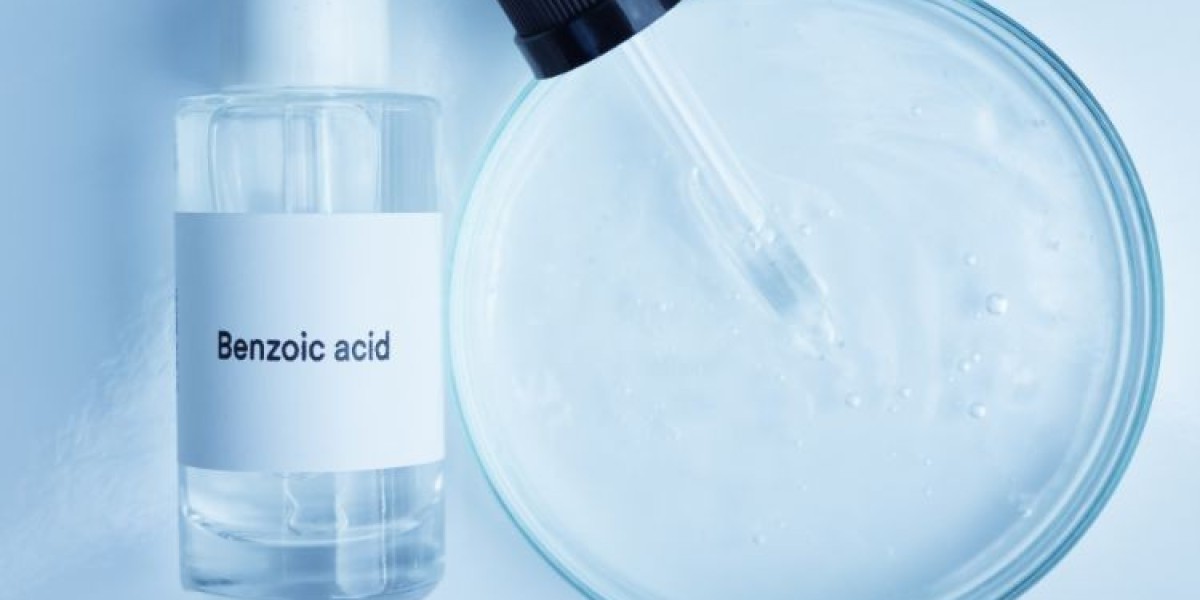The global benzoic acid market size attained a value of approximately USD 1.21 billion in 2023. The market is further expected to grow at a CAGR of around 5.50% in the forecast period of 2024-2032, reaching a value of around USD 1.96 billion by 2032. This growth is driven by several factors, including the increasing demand for preserved food and beverages, the expansion of end-use industries, and ongoing technological advancements. However, the market also faces challenges such as environmental concerns and regulatory hurdles.
Understanding Benzoic Acid: A Cornerstone of Preservation
Benzoic acid is a naturally occurring aromatic carboxylic acid found in fruits like cranberries, plums, and prunes. It has been used for centuries as a preservative due to its antifungal and antibacterial properties. In its manufactured form, benzoic acid finds application in various industries, including:
- Food & Beverages: As a food additive, benzoic acid extends the shelf life of various products like jams, jellies, soft drinks, and acidic sauces by inhibiting the growth of mold and bacteria. Sodium benzoate, a salt of benzoic acid, is the most commonly used form in this sector.
- Pharmaceuticals: Benzoic acid finds use in topical ointments to treat fungal skin infections like athlete's foot. Additionally, it serves as a precursor in the synthesis of various pharmaceutical ingredients.
- Industrial Applications: Benzoic acid acts as a key intermediate in the production of chemicals like phenol, used in plastics manufacturing, and plasticizers, which enhance flexibility in various materials.
A Look Back: The History and Evolution of Benzoic Acid
The use of benzoic acid dates back centuries. Early civilizations extracted it from natural sources like benzoin resin, a gum obtained from certain trees. This resin was valued for its medicinal and preservative properties. In the 18th century, scientists identified benzoic acid as the active component in the resin, paving the way for its commercial production. The development of synthetic production methods in the late 19th century further revolutionized the benzoic acid market, making it readily available and cost-effective for various industrial applications.
Market Dynamics: Size, Growth, and Segmentation
The benzoic acid market is experiencing steady growth due to several factors. The increasing demand for packaged and processed food, particularly in developing nations, is a major driver. Consumers' busy lifestyles and growing preference for convenience food have led to a rise in the use of preservatives like benzoic acid. Additionally, the pharmaceutical and industrial sectors are witnessing significant growth, further propelling the demand for benzoic acid.
Geographically, the Asia Pacific region currently holds the largest share of the benzoic acid market. This dominance is attributed to the region's burgeoning food and beverage industry and rapid industrial development. However, other regions like North America and Europe are also expected to witness significant growth in the coming years.
The benzoic acid market can be segmented by application and region. Here's a breakdown:
- Segmentation by Application:
- Food & Beverages (Largest Segment)
- Pharmaceuticals
- Industrial Applications
- Others (including cosmetics and personal care products)
- Geographical Segmentation:
- Asia Pacific (Dominant Segment)
- North America
- Europe
- Latin America
- Middle East & Africa
Key Trends and Developments Shaping the Market
Several trends are shaping the future of the benzoic acid market:
- Shift Towards Natural and Sustainable Sources: Consumers are increasingly opting for natural and organic products. This trend is driving the development of benzoic acid derived from natural sources like plants and fungi.
- Technological Advancements: Innovations in production processes are leading to increased efficiency and cost-effectiveness in benzoic acid manufacturing. Additionally, research on bio-based production methods using renewable resources holds promise for a more sustainable future.
- Regulatory Developments: Regulatory bodies play a crucial role in ensuring the safety of food additives like benzoic acid. Stringent regulations regarding permissible levels and usage can impact the market landscape.
Growth Drivers and Challenges: A Balancing Act
While the benzoic acid market presents promising growth opportunities, it also faces some challenges:
- Environmental Concerns: The production of benzoic acid can generate certain pollutants. Manufacturers are increasingly focusing on cleaner production methods to minimize environmental impact.
- Regulatory Hurdles: Strict regulations regarding the use of preservatives in food and beverages can restrict market growth in certain regions.
Competitive Landscape: Key Players and Strategies
The benzoic acid market is characterized by a mix of established players and emerging regional manufacturers. Some of the key players include:
- BASF SE (Germany)
- Merck Group (Germany)
- Solvay (Belgium)
- Eastman Chemical Company
- Lanxess AG (Germany)
- Wuhan Youji Industries Co. Ltd (China)
- FBC Industries, Inc (US)
- Tengzhou Tenglong Chemical Co., Ltd (China)
- A.M. Food Chemical Co. Limited (China)
Leading players in the benzoic acid market are adopting various strategies to maintain their market position and capitalize on growth opportunities. These strategies include:
- Expanding Production Capacity: Major players are investing in expanding their production capabilities to cater to the rising global demand.
- Focus on Innovation: Companies are actively involved in R&D to develop new and improved benzoic acid production methods and explore applications in emerging sectors.
- Mergers and Acquisitions: Strategic acquisitions and mergers can help companies consolidate their market share and gain access to new technologies or distribution channels.
- Sustainability Initiatives: Leading players are implementing eco-friendly practices and adopting sustainable production methods to address environmental concerns and cater to the growing demand for natural and organic products.
Future Outlook: Embracing Opportunities and Addressing Challenges
The benzoic acid market is expected to witness continued growth in the coming years. The increasing demand for preserved food and beverages, particularly in developing nations, coupled with the expansion of end-use industries, will be key drivers. However, factors like stringent regulations and environmental concerns require careful consideration.
Emerging Opportunities:
- Growing demand for natural and organic benzoic acid derivatives
- Expansion of the pharmaceutical and personal care product industries
- Technological advancements leading to cost-effective and sustainable production methods
- Increasing demand in emerging economies
Potential Threats:
- Stringent regulations and potential bans on benzoic acid use in certain regions
- Fluctuations in raw material prices
- Competition from alternative preservatives



